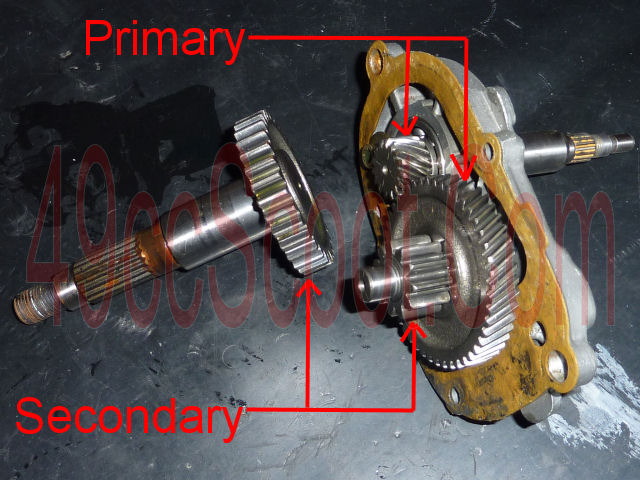Primary And Secondary And Final Drive Ratio
Mar 3, 2012 8:27:20 GMT -5
wolfbat3, creeper, and 2 more like this
Post by 90GTVert on Mar 3, 2012 8:27:20 GMT -5
This is an excerpt from my 90cc swap thread that I though would be useful here....
Now you have a choice to make. You should have both the gearset from the scooter and the ATV at your disposal at this point. Either set should be compatible with the ATV transmission case.

Both sets of gears are likely to be different final drive ratios, so you should choose the set that will be most likely to help you accomplish your goals with the engine swap. In my case, the 90cc gears would be more useful for top speed and the 50cc gears would provide superior acceleration.
90cc Gears
Primary = 15/47 = 3.133333333333333:1
Secondary = 11/31 = 2.818181818181818:1
Final Drive Ratio = 8.830303030303029:1
50cc Gears
Primary = 13/48 = 3.692307692307692:1
Secondary = 12/36 = 3:1
Final Drive Ratio = 11.07692307692308:1
If you aren't sure what all that means, let me explain it briefly and how you can find your final drive gear ratios. I believe a lot of 50cc and 90cc rations will be the same as these, but it never hurts to check.
There are 2 gearsets in the transmission that form one final drive ratio. They are the priomary and secondary gears. Primary gears are the gear on the end of the shaft drive by the clutch and the gear that it drives. Secondary gears are the gear on the axle and the gear that drives it off of the primary gears.

To determine your primary, secondary, and ultimately the final drive ratio, begin by counting the teeth on each gear and writing it down. t is often helpful to mark the tooth that you start counting on with a dot from a marker so you don't forget exactly where you started. If you have any doubt that you miscounted, do it over again to be sure.
You sohuld now have two numbers for your primary gears and two numbers for your secondary gears. Using my 90cc gears and an example :
Primary : 15 / 47
Secondary : 11 / 31
Now we can use division to determine the ratios of each gear set. Divide the number of teeth the gear being driven has by the number of teeth of the gear driving it. Again using my 90cc gears as an example :
Primary : 47 / 15 = 3.133333333333333:1
Secondary : 31 / 11 = 2.818181818181818:1
Now you know both your primary and secondary gear ratios, so you just need to combine them to determine the final drive ratio. Multiply the primary and secondary ratios to find the final drive ratio. Using my 90cc gears as an example again :
3.133333333333333(Primary) x 2.818181818181818(Secondary) = 8.830303030303029:1(Final)
You've determined the final drive ratios of each gearset, but what do those numbers mean? The gear ratio expresses how many revolutions of input are needed to output one revolution. In the case of the final drive ratio, the number represents the quantity of revolutions of the clutch bell turning the driveshaft that are needed to rotate the tire one full revolution. For example, my 90cc gears have an 8.830303030303029:1 final drive ratio. So my clutch bell revolves 8.830303030303029 times in order to rotate my rear tire just once.
The more times the clutch bell has to rotate to spin the rear tire once, the greater the potential for acceleration. The less revolutions the clutch bell needs to make to rotate the rear tire once, the greater the potential for top speed.
Numerically Higher Gear Ratios = Greater Acceleration/Higher Cruise RPM
Numerically Lower Gear Ratios = Greater Top Speed/Lower Cruise RPM
Determining exactly what speed you can achieve with these gear ratios is a little tricky, but the numbers should give you some idea of what you want to try. I went with the scooter gears (11.08:1) on this build and so far I've seen 58MPH at as much as 8,800RPM. Acceleration is great.

